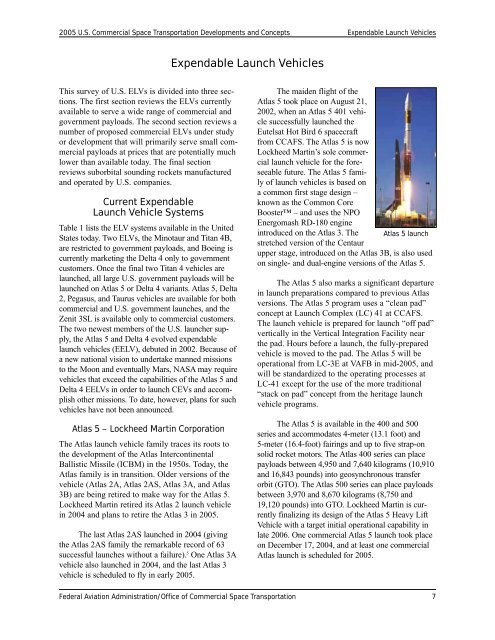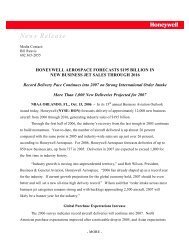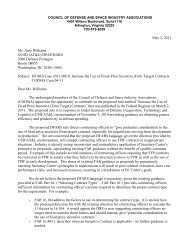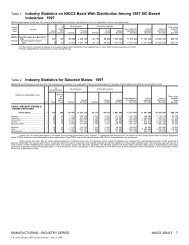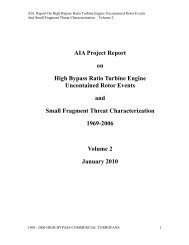Untitled - Aerospace Industries Association
Untitled - Aerospace Industries Association
Untitled - Aerospace Industries Association
You also want an ePaper? Increase the reach of your titles
YUMPU automatically turns print PDFs into web optimized ePapers that Google loves.
2005 U.S. Commercial Space Transportation Developments and Concepts Expendable Launch VehiclesExpendable Launch VehiclesThis survey of U.S. ELVs is divided into three sections.The first section reviews the ELVs currentlyavailable to serve a wide range of commercial andgovernment payloads. The second section reviews anumber of proposed commercial ELVs under studyor development that will primarily serve small commercialpayloads at prices that are potentially muchlower than available today. The final sectionreviews suborbital sounding rockets manufacturedand operated by U.S. companies.Current ExpendableLaunch Vehicle SystemsTable 1 lists the ELV systems available in the UnitedStates today. Two ELVs, the Minotaur and Titan 4B,are restricted to government payloads, and Boeing iscurrently marketing the Delta 4 only to governmentcustomers. Once the final two Titan 4 vehicles arelaunched, all large U.S. government payloads will belaunched on Atlas 5 or Delta 4 variants. Atlas 5, Delta2, Pegasus, and Taurus vehicles are available for bothcommercial and U.S. government launches, and theZenit 3SL is available only to commercial customers.The two newest members of the U.S. launcher supply,the Atlas 5 and Delta 4 evolved expendablelaunch vehicles (EELV), debuted in 2002. Because ofa new national vision to undertake manned missionsto the Moon and eventually Mars, NASA may requirevehicles that exceed the capabilities of the Atlas 5 andDelta 4 EELVs in order to launch CEVs and accomplishother missions. To date, however, plans for suchvehicles have not been announced.Atlas 5 – Lockheed Martin CorporationThe Atlas launch vehicle family traces its roots tothe development of the Atlas IntercontinentalBallistic Missile (ICBM) in the 1950s. Today, theAtlas family is in transition. Older versions of thevehicle (Atlas 2A, Atlas 2AS, Atlas 3A, and Atlas3B) are being retired to make way for the Atlas 5.Lockheed Martin retired its Atlas 2 launch vehiclein 2004 and plans to retire the Atlas 3 in 2005.The last Atlas 2AS launched in 2004 (givingthe Atlas 2AS family the remarkable record of 63successful launches without a failure). 5 One Atlas 3Avehicle also launched in 2004, and the last Atlas 3vehicle is scheduled to fly in early 2005.The maiden flight of theAtlas 5 took place on August 21,2002, when an Atlas 5 401 vehiclesuccessfully launched theEutelsat Hot Bird 6 spacecraftfrom CCAFS. The Atlas 5 is nowLockheed Martin’s sole commerciallaunch vehicle for the foreseeablefuture. The Atlas 5 familyof launch vehicles is based ona common first stage design –known as the Common CoreBooster – and uses the NPOEnergomash RD-180 engineintroduced on the Atlas 3. The Atlas 5 launchstretched version of the Centaurupper stage, introduced on the Atlas 3B, is also usedon single- and dual-engine versions of the Atlas 5.The Atlas 5 also marks a significant departurein launch preparations compared to previous Atlasversions. The Atlas 5 program uses a “clean pad”concept at Launch Complex (LC) 41 at CCAFS.The launch vehicle is prepared for launch “off pad”vertically in the Vertical Integration Facility nearthe pad. Hours before a launch, the fully-preparedvehicle is moved to the pad. The Atlas 5 will beoperational from LC-3E at VAFB in mid-2005, andwill be standardized to the operating processes atLC-41 except for the use of the more traditional“stack on pad” concept from the heritage launchvehicle programs.The Atlas 5 is available in the 400 and 500series and accommodates 4-meter (13.1 foot) and5-meter (16.4-foot) fairings and up to five strap-onsolid rocket motors. The Atlas 400 series can placepayloads between 4,950 and 7,640 kilograms (10,910and 16,843 pounds) into geosynchronous transferorbit (GTO). The Atlas 500 series can place payloadsbetween 3,970 and 8,670 kilograms (8,750 and19,120 pounds) into GTO. Lockheed Martin is currentlyfinalizing its design of the Atlas 5 Heavy LiftVehicle with a target initial operational capability inlate 2006. One commercial Atlas 5 launch took placeon December 17, 2004, and at least one commercialAtlas launch is scheduled for 2005.Federal Aviation Administration/Office of Commercial Space Transportation 7


